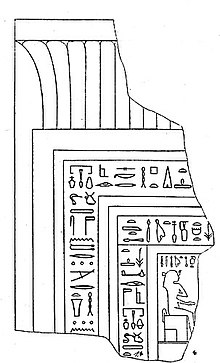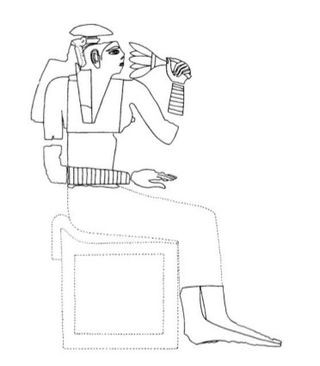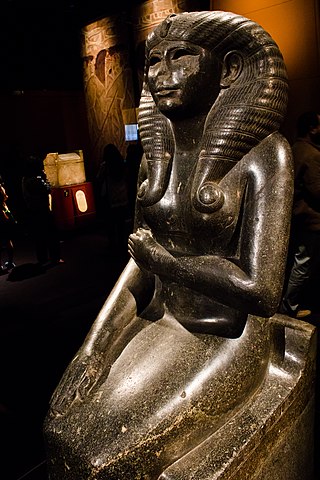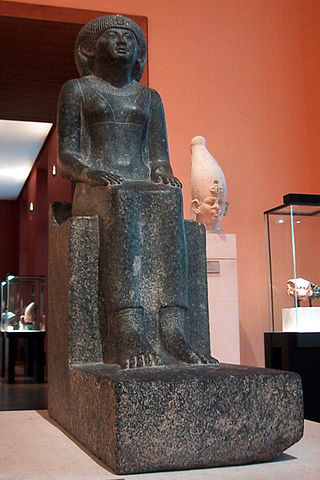
| Aat in hieroglyphs | ||
|---|---|---|
| Era: Middle Kingdom (2055–1650 BC) | ||
Aat ("The Great One") was a queen of the ancient Egyptian 12th Dynasty. Of all the wives of Amenemhat III, only her name is known to modern archaeology with any certainty. [1]

| Aat in hieroglyphs | ||
|---|---|---|
| Era: Middle Kingdom (2055–1650 BC) | ||
Aat ("The Great One") was a queen of the ancient Egyptian 12th Dynasty. Of all the wives of Amenemhat III, only her name is known to modern archaeology with any certainty. [1]
Aat was buried at Dahshur, under her husband's pyramid, along with another queen whose name is lost. [1] [2] Her burial chamber is under the south side of the pyramid. The box with the canopic jars was put in a niche above the entrance.[ citation needed ]
Although the tomb was robbed in antiquity, archaeologists found her sarcophagus, a false door and an offering table [1] along with a few pieces of burial equipment, such as seven alabaster bowls in the form of ducks, two mace heads, pieces of jewelry and one of the canopic jars. Among the burial items of the other queen buried in the adjoining chamber were obsidian and alabaster bowls, granite and alabaster mace heads and some jewels, along with the pieces of a small stone shrine.[ citation needed ] Aat was about 35 years old at her death, the other queen was about 25. Their bones were found. [2]
Aat's titles were: “King's Wife”, “United with the White Crown”. [1]
She was one of the many wives of Amenemhat lll. She may have been the mother of Sobekneferu.[ citation needed ]

Amenemhat III, also known as Amenemhet III, was a pharaoh of ancient Egypt and the sixth king of the Twelfth Dynasty of the Middle Kingdom. He was elevated to throne as co-regent by his father Senusret III, with whom he shared the throne as the active king for twenty years. During his reign, Egypt attained its cultural and economic zenith of the Middle Kingdom.

Sobekneferu or Neferusobek was a pharaoh of ancient Egypt and the last ruler of the Twelfth Dynasty of the Middle Kingdom. She ascended to the throne following the death of Amenemhat IV, possibly her brother or husband, though their relationship is unproven. Instead, she asserted legitimacy through her father Amenemhat III. Her reign lasted 3 years, 10 months, and 24 days, according to the Turin King List.

Aspelta was a ruler of the kingdom of Kush. More is known about him and his reign than most of the rulers of Kush. He left several stelae carved with accounts of his reign.

Nubkaure Amenemhat II, also known as Amenemhet II, was the third pharaoh of the 12th Dynasty of ancient Egypt. Although he ruled for at least 35 years, his reign is rather obscure, as well as his family relationships.

Tomb KV43 is the burial place of Thutmose IV, a pharaoh of the Eighteenth Dynasty in the Valley of the Kings in Luxor, Egypt. He was interred with two of his children who predeceased him. The tomb has a dog-leg shape, typical of the layout of early Eighteenth dynasty tombs. KV43 was rediscovered in 1903 by Howard Carter, excavating on behalf of Theodore M. Davis.
Lisht or el-Lisht is an Egyptian village located south of Cairo. It is the site of Middle Kingdom royal and elite burials, including two pyramids built by Amenemhat I and Senusret I. The two main pyramids were surrounded by smaller pyramids of members of the royal family, and many mastaba tombs of high officials and their family members. They were constructed throughout the Twelfth and Thirteenth Dynasties. The site is also known for the tomb of Senebtisi, found undisturbed and from which a set of jewelry has been recovered. The pyramid complex of Senusret I is the best preserved from this period. The coffins in the tomb of Sesenebnef present the earliest versions of the Book of the Dead.

Hor Awibre was an Egyptian pharaoh of the early 13th Dynasty in the late Middle Kingdom.

Mutnedjmet, also spelled Mutnodjmet, Mutnedjemet, etc., was an ancient Egyptian queen, the Great Royal Wife of Horemheb, the last ruler of the 18th Dynasty. The name, Mutnedjmet, translates as: "The sweet Mut" or "Mut is sweet." She was the second wife of Horemheb after Amenia who died before Horemheb became pharaoh.

Neferuptah or Ptahneferu was a daughter of the Egyptian king Amenemhat III of the 12th Dynasty. Her sister was the Pharaoh Sobekneferu.

Hetepheres I was a queen of Egypt during the Fourth Dynasty of Egypt who was a wife of one king, the mother of the next king, the grandmother of two more kings, and the figure who tied together two dynasties.

The Black Pyramid was built by King Amenemhat III during the Middle Kingdom of Egypt. It is one of the five remaining pyramids of the original eleven pyramids at Dahshur in Egypt. Originally named Amenemhet is Mighty, the pyramid earned the name Black Pyramid for its dark, decaying appearance as a rubble mound. The Black Pyramid was the first to house both the deceased pharaoh and his queens. Jacques de Morgan, on a French mission, began the excavation on the pyramids at Dahshur in 1892. The German Archaeological Institute of Cairo completed excavation in 1983.

Ameny Qemau was an Egyptian pharaoh of the early 13th Dynasty in the late Middle Kingdom.

Menhet, Menwi and Merti, also spelled Manhata, Manuwai and Maruta, were three minor foreign-born wives of Pharaoh Thutmose III of the Eighteenth Dynasty. They are known for their lavishly furnished rock-cut tomb in Wady Gabbanat el-Qurud near Luxor, Egypt. They are suggested to be Syrian, as the names all fit into Canaanite name forms, although their ultimate origin is unknown. A West Semitic origin is likely, but both West Semitic and Hurrian derivations have been suggested for Menwi. Each of the wives bear the title of "king's wife", and were likely only minor members of the royal harem. It is not known if the women were related as the faces on the lids of their canopic jars are all different.

Sithathoriunet was an Ancient Egyptian king's daughter of the 12th Dynasty, mainly known from her burial at El-Lahun in which a treasure trove of jewellery was found. She was possibly a daughter of Senusret II since her burial site was found next to the pyramid of this king. If so, this would make her one of five known children and one of three daughters of Senusret II—the other children were Senusret III, Senusretseneb, Itakayt and Nofret.
Nubhetepti-khered was an ancient Egyptian king's daughter of the Thirteenth Dynasty. She is only known from her undisturbed burial at Dahshur which was discovered in 1894 by Jacques de Morgan, close to the pyramid of Amenemhat III.
Neferu was an ancient Egyptian queen of the 12th Dynasty. She was a daughter of Amenemhat I, sister-wife of Senusret I and the mother of Amenemhat II.

Nofret II was an ancient Egyptian queen of the 12th dynasty. She was a daughter of Amenemhat II and wife of Senusret II.

Khenemetneferhedjet I Weret was an ancient Egyptian queen of the 12th Dynasty, a wife of Senusret II and the mother of Senusret III.
Udjebten or Wedjebten was an ancient Egyptian queen consort, a wife of Pharaoh Pepi II of the Sixth Dynasty.
Rekhetre was an ancient Egyptian queen from the late 4th Dynasty or early 5th Dynasty. She was a daughter of Pharaoh Khafre. Her husband is never mentioned, but Rekhetre would have been the wife of one of Khafre's successors, possibly Menkaure.